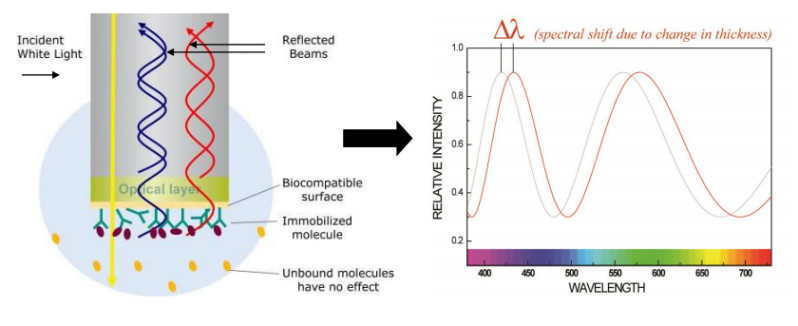Service Line:+1-315-239-3085
Address:FL-4, Building A5, International Enterprise Community, Tianjin, China
Email:info@kmdbioscience.com
Biolayer Interferometry (BLI) is an advanced technique for real-time monitoring of unlabeled biomolecular interactions at optical level. The technique uses probe biosensor to directly detect the samples, and detects the Binding and dissociation between the interacting biomolecules on the sensor surface by detecting the displacement change of interference spectrum. Compared with traditional molecular interaction techniques (Co-immunoprecipitation, Pull Down, EMSA, ELISA, etc.), BLI affinity assay can be quantitatively determined.
KMD Bioscience has built a mature Octet platform that can deliver multiple types of sensors. Our research experts have been dedicated to the study of biomolecular interactions for many years. With the help of Octet system, we are able to provide our customers with accurate and rapid BLI affinity testing services, ensuring accurate, objective and reliable test results.
Biolayer Interferometry Technology(BLI):
Biofilm interferometry is a labeling free, real-time monitoring optical detection technology, which is mainly used for the comprehensive quantitative analysis of biomolecular interaction and the determination of protein concentration. The technique uses probe biosensor to directly detect the samples, and detects the Binding and dissociation between the interacting biomolecules on the sensor surface by detecting the displacement change of interference spectrum. Ligand binding to the end of the sensor will form a layer of biofilm. When the analyte binds to the ligand, the molecular weight of the end of the sensor will change, resulting in a change in the thickness of the biofilm. After light passes through the biofilm layer of the sensor, interference light waves are formed through transmission and reflection. The change of biofilm thickness leads to the relative displacement of interference light waves, forming the interference spectrum. The data is displayed by the real-time displacement (nm) of the interference spectrum. The schematic diagram is shown in Figure 2.

Figure 2 BLI Principle
BLI can detect proteins, nucleic acids, polysaccharides, lipids, small molecule drugs, antibodies, viruses, bacteria and cells and other samples. It has been widely used in protein structural target analysis, drug development and screening, immunology, gene regulation, signaling pathway, genetics, microbiome, virology, nanoparticles, liposomes, Chinese herbal extracts and natural product analysis and other life science research fields.
Service Range:
KMD Bioscience provides label-free molecule interaction services based on BLI technology: Protein-Protein affinity detection; Antigen-Antibody affinity detection; Protein-Small molecule compounds affinity detection; Protein-DNA affinity detection; Antibody isotyping analysis; Antibody pairing; hybridoma screening, etc. As well as many other compounds and high-throughput affinity sequencing services according to customer requirements.
We have more than ten types of sensors to meet the various needs of different samples. According to different experimental samples and purposes, KMD Bioscience will choose matched sensors for your experiments.
|
Sensor Type |
Sensor Name |
|
Common Type |
* Streptavidin (SA) * Super Streptavidin (SSA) * High Precision Streptavidin (SAX) * Amine Reactive 2nd Generation (AR2G) * Aminopropylsilane (APS) |
|
Capture Type |
* Anti-Penta-HIS(HIS) * Ni-NTA(HIS) * Anti-GST |
|
Antibody Type |
* Anti-Human IgG Fc (AHQ) * Anti-Human IgG Fc (AHC) * Anti-Murine IgG Fv (AMQ) * Anti-Murine IgG Fc (AMC) * Anti Human IgG Fab (FAB2G) * Protein A * Protein G * Protein |
Sample Requirements:
|
Customer provides |
Requirements |
|
Customer can provide antibody/protein/peptide/small molecular compound etc. |
* Buffer: PBS, HEPPS etc. Try not to contain glycerol, imidazole, trehalose or other salts; try to avoid reagents with amino groups such as Tris as a buffer. * Protein: labeled > 100μg, unlabeled > 200μg, concentration > 0.5mg/ml, purity > 90%, avoiding particle or flocculent precipitation. * Antibody: > 200μg, concentration > 0.5mg/ml, purity > 90%, avoiding particle or flocculent precipitation. * Polypeptide: with biotin label > 200μg, without biotin label > 2mg, concentration > 0.1mg/ml, purity > 90%, avoiding particle or flocculent precipitation. * Small molecule (powder or liquid, which can be dissolved in water or DMSO): > 1mg, concentration > 1mg/ml, purity > 90%, soluble in 100% DMSO or water. |
Service Highlights:
-- Professional technical team and rich technical experience
-- High detection efficiency, no labeling, real-time monitoring
-- Advanced instruments and equipment
-- A wide range of applications: can be used for protein, nucleic acid, peptides, nanomaterials and other molecular interaction analysis
-- One-stop service: from affinity measurement services, to molecular interaction research integrated solutions
Service Content:
--Affinity and kinetic determination
--Screening of small molecular compounds (antibodies)
--Consistency evaluation and quality control testing
How to Order?

If you have any questions regarding our services or products, please feel free to contact us by E-mail: info@kmdbioscience.com or Tel: +86-400-621-6806